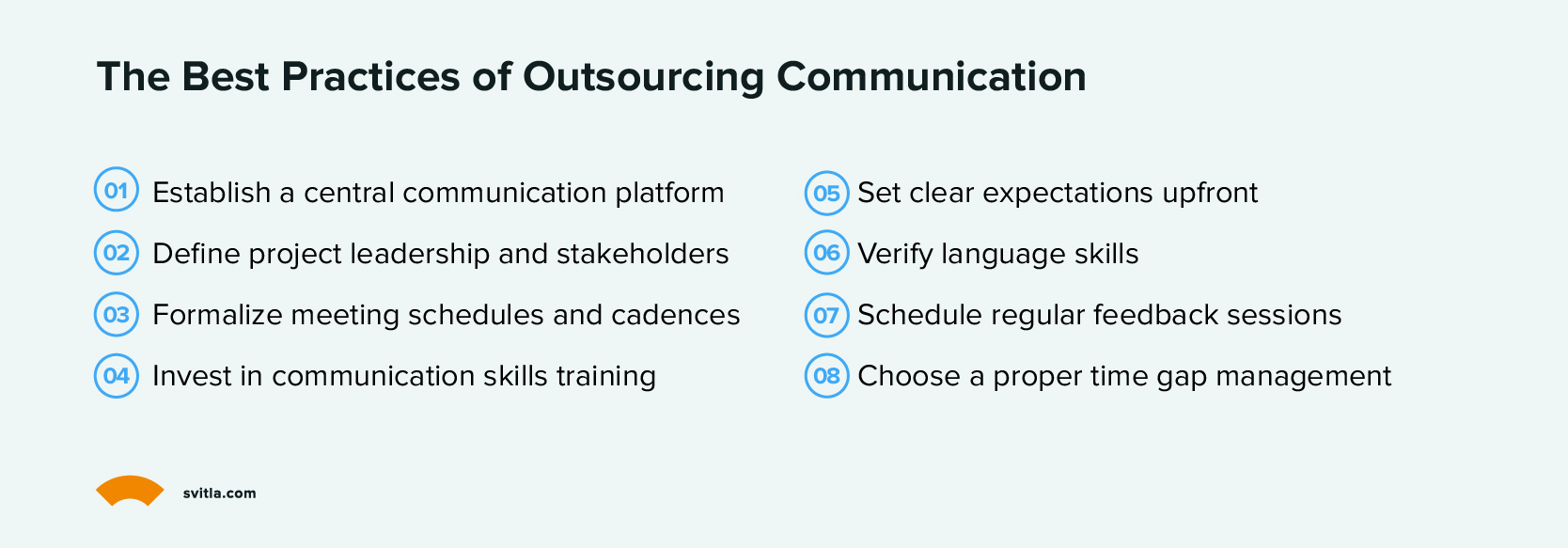Outsourcing software development has become common today in the tech world. It started slowly back in the day but has exploded recently thanks to process optimization and affordable pricing. Over 90% of the Global 2000 corporations use outsourcing for IT, and the momentum is still strong.
Many big companies outsource their software projects, so their teams can focus on their core business while outside teams tackle the tech projects. According to a 2022 study by McKinsey, 87% of companies said they have gaps in their IT departments and that outsourcing helps avoid production bottlenecks.
Building software requires some particular skill sets nowadays. So, by tapping into the global talent pool through outsourcing partners, companies can access those critical capabilities efficiently and cost-effectively. At first, businesses were reluctant to outsource tech work, but today, they recognize its value in achieving goals and controlling costs. The digital landscape moves incredibly fast, so flexible staffing options allow companies to keep pace.
Yet, despite the numerous benefits of software outsourcing, it is also connected with certain challenges. The most discussed one is the communication problems in software development. This article will discuss why it happens and how you can solve this problem. Keep reading to know more.
What Leads to Communication Gaps in Software Outsourcing?
Clear communication in software development is critical for successful outsourcing. Still, a few things can muddle the process:
Cultural Differences
Cultural barriers can seriously affect communication when outsourcing software development to another country. Different norms, communication styles, and expectations across cultures can lead to misunderstandings or people taking offense unintentionally.
For example, direct feedback might be seen as a helpful critique in some places, while it comes across as rude in others. In some cultures, indirect language and nonverbal signals carry more meaning. These differences can confuse project needs and constraints.
Companies should acknowledge these gaps and promote open, clear communication across teams. Cross-cultural training, encouraging dialogue, and inclusive work environments are some ways to get aligned.
Time Zone Differences
The time zone split between teams also messes with streamlined communication in outsourcing. When people are distributed across time zones, scheduling meetings, resolving urgent issues, and getting real-time input is tougher.
Just imagine a critical bug pops up, and the development team requires answers from the client, but they're asleep on the other side of the world right now. Delays like this can hamper projects staying on track.
You must implement protocols to bridge time zone divisions in distributed teams, ensuring access to information and smooth collaboration. Tactics could include overlapping working hours, communication tools with offline access, and having point people across time zones.
Technical Jargon Mishaps
Software development comes loaded with technical terms that may bewilder non-technical people involved in a project. Mix-ups around these terms can snowball into misunderstandings about requirements.
For example, the development team might refer to a feature by its technical name, assuming the client understands it. However, the client imagines something different, leading to mismatches between expectations and the end product.
The common understanding of technical language is vital to avoiding this. Creating a glossary of terms, holding knowledge shares, and keeping open communication channels for questions can get everyone on the same page. Diagrams and prototypes also help connect technical concepts to tangible deliverables.
By tackling these communication gaps, companies can enhance collaboration, meet project goals, and build strong partnerships with outsourcing teams. Investing in clear communication is essential to bridge common divides successfully.
Potential Pitfalls of Poor Communication
Effective communication in software development is the lifeblood of successful projects, and its absence can lead to numerous issues. In this part, we delve into the main pitfalls of poor communication. Let’s start.
Missed Deadlines
When communication breaks down, there's a suitable chance tasks get misunderstood or done incorrectly. Ambiguous instructions can send people down the wrong path, wasting time and resources. And it cascades – the project timeline slips, deadlines get missed, and budgets get busted. Rework also tanks team morale and erodes trust between members. It's a messy domino effect triggered by unclear communication and expectations.
Poor Quality
The external team must deeply understand the intricate details and requirements to nail an outsourced software project. If subtle specifics get lost in translation, the end product suffers from quality issues that don't align with benchmarks or user expectations. These deficiencies drain even more time and money on rework. It also may hurt the brand reputation and miss market opportunities. Having a shared vision and constant collaboration is vital – everyone across locations and roles must rally behind the same goals to execute smoothly.
Damaged Relationships
When communication struggles to persist, it compromises trust and understanding within a team over time. Small issues snowball as frustrations boil over into significant disagreements or tensions between partners. People second-guess intentions rather than seeking clarification. Eventually, no one wants to continue collaborating, jeopardizing current progress and future partnerships. Constructive relationships hinge on open dialogue to surface misunderstandings quickly rather than letting them fester.
Best Practices to Bridge Outsourcing Communication Gap
Now, let's discuss some good ideas and tips for improving communication and addressing the issues we listed earlier. Let’s start.

Tip #1. Establish a Central Communication Platform
Both parties should agree on a communication tool for all team members, such as Slack, Microsoft Teams, or a dedicated project management platform like Asana or Trello. These tools keep meaningful conversations and documents centralized for easy reference. Check-in periodically to ensure the chosen communication method remains effective as project needs shift over time. This provides optimal information sharing as the work progresses.
Tip #2. Define Project Leadership and Stakeholders
One more significant thing is identifying the project decision-maker. This project leader will gather team feedback and retain the final say over crucial next steps. Ensuring only directly involved team members provide suggestions reduces irrelevant opinions and scope creep. Instruct extended stakeholders to funnel input through the designated decision-maker when necessary.
Tip #3. Formalize Meeting Schedules and Cadences
Establish minimum notice periods for calling impromptu meetings, such as 24 or 48 hours. Shared calendars allow members to review availability before confirming timing. Services like Calendly and Doodle offer multiple time slots that efficiently work with everyone’s existing commitments. Automated scheduling aligns meetings to optimal times.
Tip #4. Invest in Communication Skills Training
Soft skill-building activities teach members to understand needs better and express complex information. Role-playing and presentations allow practice articulating requirements. Hone the art of active listening, effective questioning, and paraphrasing feedback to capture details fully. Taking the time to comprehend wishes prevents misaligned deliverables.
Tip #5. Set Clear Expectations Upfront
Effective outsourcing requires defined expectations early on and proper team understanding. More detailed and realistic objectives agreed upon at the start minimize confusion.
An experienced outsourcing provider actively shapes pragmatic goals based on proven capabilities. Strong partners know precise requirements make for better collaboration.
Tip #6. Verify Language Skills
Outsourced development generally relies on English as the primary common language for smooth communication. While other languages can be used if parties agree, English fluency is a must-have for outsourced team members. A reliable vendor ensures its team demonstrates an intermediate English level at a minimum, with proficiency strongly preferred. Checking language abilities upfront prevents issues from unclear exchanges.
Additional shared languages may further optimize understanding but are not obligatory. The priority is confirming a baseline English capability sufficient for technical collaboration.
Tip #7. Schedule Regular Feedback Sessions
Holding regular check-in meetings is critical for aligning teams. Short weekly or bi-weekly sync-ups provide a platform for:
- Progress updates. Teams report on milestones achieved, highlight any blocking issues, and outline the next steps.
- Feedback exchange. Participants can ask clarifying questions, offer suggestions to improve workflows, and reconfirm objectives.
Frequent, open communication enables proactive issue resolution and continuous process improvements. Team members feel involved when given opportunities to provide regular progress reports and voice feedback.
The consistent collaboration also ensures goals remain transparent to all and projects stay on track toward collective success.
Tip #8. Choose a Proper Time Gap Management
Managing time zones well is key for good outsourcing communication. Smart providers use two main strategies:
- Shift team hours. The provider changes its developers' schedules to match the client's working hours. This allows for real-time collaboration.
- Daily overlap meetings. Short meetings are held during a 4-6 hour window when both teams' days overlap. This face-time covers progress, questions, and issue resolution.
While time differences can be challenging, flexibility and daily check-ins help ensure seamless coordination. Meetings leverage the shared window to focus on top priorities. With the right strategies, timezone gaps don't have to reduce outsourcing success. It's about adapting provider hours and using overlap for aligned communication. The results are productive partnerships.
Tip #9. Bridge Cultural Gaps
Respectfully educate team members on region-specific etiquette, communication styles, work norms, and taboos to avoid misinterpreting behaviors or causing unintended offense.
When outsourcing across cultures, anticipate differences in holidays and days off. Rather than completely shutting down, proactively plan around key dates. The provider should map both sides' expected days off and schedule work and meetings accordingly. For example, if the client is out for a holiday, plan tasks that don't require their direct input that day.
The goal is to respect significant days off while preventing disrupted workflows. With coordination legwork on the provider side, teams can work around known gaps or reduced availability.
The key is planning and setting realistic expectations around cultural and holiday differences. Outsourcing partners can uphold productivity year-round through thoughtful scheduling that demonstrates cross-cultural respect.
Wrapping Up
Outsourcing software development can provide many advantages, but clear communication is critical to achieving them. Outsourcing providers must address any communication issues that come up to meet deadlines, maintain quality, and build strong relationships with their providers.
Communication barriers include cultural differences, time zones, and confusion over technical terms. But there are strategies companies can use to get around these problems. For example, having one leading platform for communication, designating a project leader, setting up regular meetings, and training people on communication skills in software development. It also works to define expectations early on, double-check language abilities, manage time differences, and bridge cultural gaps.
Following these tips, you can build trust and create an environment for thriving partnerships. Taking advantage of global talent becomes much easier when everyone works harmoniously.
At Svitla Systems, we have a proven track record of outsourced projects. Reach out if you'd like to explore how we can collaborate on your next project.





![[Blog cover] SEO optimization best practices](https://svitla.com/wp-content/uploads/2025/05/Blog-cover-SEO-optimization-best-practices-560x310.jpg)